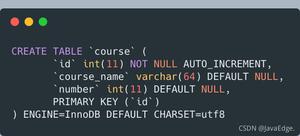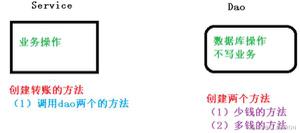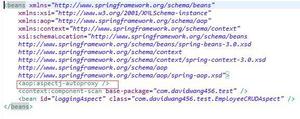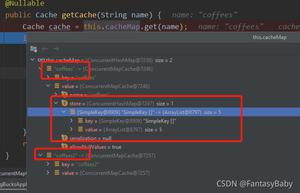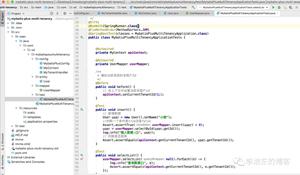Spring事务管理--多个ORM框架在使用时的情况分析
本文内容纲要:Spring事务管理--多个ORM框架在使用时的情况分析
公司的项目已经接近尾声了,总结一下项目中用到的技术,我发现项目中的有些东西还是挺模糊的,只是知道这么用就行了。并不清楚其中的原理。由于公司的项目比较老,是7年前的一个项目了,中间一直有人在维护,也是在这个过程中不断融入了新的东西,比如就项目的持久化这块来说,就用了ibatis、mybatis、hibernate、spring JDBC四种混合的框架。究其原因只能说是历史遗留问题,就不做过多的解释了。但是这么多持久化的框架如何协同工作的,尤其是事务的控制,一个系统中使用如此多的持久化框架是,他们是如何正确的进行事务控制的,甚至有些业务逻辑同时调用了使用这些不同框架的方法。这听起来确实有些困难。我们知道Spring为每种数据访问技术提供了相应的事务管理器,难道需要分别为它们配置对应的事务管理器吗?它们到底是如何协作和工作的呢?这些层出不穷的问题往往压制了开发人员使用联合军种的想法。
Spring事务管理器的应对
Spring抽象的DAO体系兼容多种数据访问技术,它们各有特色,各有千秋。像Hibernate是非常优秀的ORM实现方案,但对底层SQL的控制不太方便;而iBatis则通过模板化技术让你方便地控制SQL,但没有Hibernate那样高的开发效率;自由度最高的当然是直接使用SpringJDBC了,但它也是底层的,灵活的代价是代码的繁复。很难说哪种数据访问技术是最优秀的,只有在某种特定的场景下才能给出答案。所以在一个应用中,往往采用多个数据访问技术:一般是两种,一种采用ORM技术框架,而另一种采用偏JDBC的底层技术,两者珠联璧合,形成联合军种,共同御敌。
其实,在这个问题上,我们低估了Spring事务管理的能力。
如果你采用了一个高端ORM技术(Hibernate、JPA、JDO),同时采用一个JDBC技术(Spring JDBC、iBatis),
由于前者的会话(Session)是对后者连接(Connection)的封装,Spring会“足够智能地”在同一个事务线程让前者的会话封装后者的连接。
所以,我们只要直接采用前者的事务管理器就可以了。
表1给出了混合数据访问技术框架所对应的事务管理器。
序 号 | 混合数据访问技术框架 | 事务管理器 |
1 | Hibernate+ Spring JDBC或iBatis | org.springframework.orm.hibernate3.HibernateTransactionManager |
2 | JPA+Spring JDBC或iBatis | org.springframework.orm.jpa.JpaTransactionManager |
3 | JDO+Spring JDBC或iBatis | org.springframework.orm.jdo.JdoTransactionManager |
Hibernate+Spring JDBC混合框架的事务管理
由于一般不会出现同时使用多个ORM框架的情况(如Hibernate+JPA),我们不拟对此命题展开论述,只重点研究ORM框架+JDBC框架的情况。Hibernate+Spring JDBC可能是被使用得最多的组合,本节我们通过实例观察事务管理的运作情况。
package com.baobaotao.mixdao;…
@Service("userService")
public class UserService extends BaseService {
@Autowired
private HibernateTemplate hibernateTemplate;
@Autowired
private ScoreService scoreService;
public void logon(String userName) {
//①通过Hibernate技术访问数据
System.out.println("before updateLastLogonTime()..");
updateLastLogonTime(userName);
System.out.println("end updateLastLogonTime()..");
//②通过JDBC技术访问数据
System.out.println("before scoreService.addScore()..");
scoreService.addScore(userName, 20);
System.out.println("end scoreService.addScore()..");
}
public void updateLastLogonTime(String userName) {
User user = hibernateTemplate.get(User.class,userName);
user.setLastLogonTime(System.currentTimeMillis());
hibernateTemplate.update(user);
//③这句很重要,请看下文的分析
hibernateTemplate.flush();
}
}
在①处,使用Hibernate操作数据,而在②处调用ScoreService#addScore(),该方法内部使用Spring JDBC操作数据。
在③处,我们显式调用了flush()方法,将Session中的缓存同步到数据库中(即马上向数据库发送一条更新记录的SQL语句)。之所以要显式执行flush()方法,原因是在默认情况下,Hibernate对数据的更改只是记录在一级缓存中,要等到事务提交或显式调用flush()方法时才会将一级缓存中的数据同步到数据库中,而提交事务的操作发生在 logon()方法返回前。如果所有针对数据库的更改操作都使用Hibernate,这种数据同步的延迟机制并不会产生任何问题。但是,我们在logon()方法中同时采用了Hibernate和Spring JDBC混合数据访问技术,Spring JDBC无法自动感知Hibernate一级缓存,所以如果不及时调用flush()方法将记录数据更改的一级缓存同步到数据库中,则②处通过Spring JDBC进行数据更改的结果将被Hibernate一级缓存中的更改覆盖掉,因为Hibernate一级缓存要等到logon()方法返回前才同步到数据库!
ScoreService使用SpringJDBC数据访问技术,其代码如下所示:
package com.baobaotao.mixdao;import org.springframework.beans.factory.annotation.Autowired;
import org.springframework.jdbc.core.JdbcTemplate;
import org.springframework.stereotype.Service;
import org.apache.commons.dbcp.BasicDataSource;
@Service("scoreService")
public class ScoreService extends BaseService{
@Autowired
private JdbcTemplate jdbcTemplate;
public void addScore(String userName, int toAdd) {
String sql = "UPDATE t_user u SET u.score = u.score + ? WHERE user_name =?";
jdbcTemplate.update(sql, toAdd, userName);
BasicDataSource basicDataSource = (BasicDataSource) jdbcTemplate.getDataSource();
//①查看此处数据库激活的连接数量
System.out.println("[scoreUserService.addScore]激活连接数量:"
+basicDataSource.getNumActive());
}
}
Spring关键的配置文件代码如下所示:
… <!--①使用Hibernate事务管理器 -->
<bean id="hiberManager"
class="org.springframework.orm.hibernate3.HibernateTransactionManager"
p:sessionFactory-ref="sessionFactory"/>
<!--②使UserService及ScoreService的公用方法都拥有事务 -->
<aop:config proxy-target-class="true">
<aop:pointcut id="serviceJdbcMethod"
expression="within(com.baobaotao.mixdao.BaseService+)"/>
<aop:advisor pointcut-ref="serviceJdbcMethod"
advice-ref="hiberAdvice"/>
</aop:config>
<tx:advice id="hiberAdvice" transaction-manager="hiberManager">
<tx:attributes>
<tx:method name="*"/>
</tx:attributes>
</tx:advice>
</beans>
启动Spring容器,执行UserService#logon()方法,可以查看到如下的执行日志:
before userService.logon().. ①在执行userService.logon()后,Spring开启一个事务
Creating new transaction with name [com.baobaotao.mixdao.UserService.logon]: PROPAGATION_REQUIRED,ISOLATION_DEFAULT
opened session at timestamp: 13009379637
Opened new Session [org.hibernate.impl.SessionImpl@c5f468] for Hibernate transaction
…
Exposing Hibernate transaction as JDBC transaction [jdbc:mysql://localhost:3306/sampledb, UserName=root@localhost, MySQL-AB JDBC Driver]
before userService.updateLastLogonTime()..
②userService.updateLastLogonTime()执行时自动绑定到①处开启的Session中
Found thread-bound Session for HibernateTemplate
loading entity: [com.baobaotao.User#tom]
about to open PreparedStatement (open PreparedStatements: 0, globally: 0)
…
about to close PreparedStatement (open PreparedStatements: 1, globally: 1)
Not closing pre-bound Hibernate Session after HibernateTemplate
end updateLastLogonTime()..
before scoreService.addScore()..
③scoreService.addScore()执行时绑定到①处开启的Session中,并加入其所对应的事务中
Found thread-bound Session [org.hibernate.impl.SessionImpl@c5f468] for Hibernate
transaction
Participating in existing transaction
…
SQL update affected 1 rows
④此时数据源只打开了一个连接
[scoreUserService.addScore]激活连接数量:1
end scoreService.addScore()..
Initiating transaction commit
⑤提交Hibernate的事务,它将触发一级缓存到数据库的同步
Committing Hibernate transaction on Session [org.hibernate.impl.SessionImpl@c5f468]
commit
processing flush-time cascades
dirty checking collections
Flushed: 0 insertions, 0 updates, 0 deletions to 1 objects
Flushed: 0 (re)creations, 0 updates, 0 removals to 0 collections
listing entities:
com.baobaotao.User{lastLogonTime=1300937963882, score=10, userName=tom, password=123456}
re-enabling autocommit
⑥提效Session底层所绑定的JDBC Connection所对应的事务
committed JDBC Connection
transaction completed on session with on_close connection release mode; be sure to close the session to release JDBC resources!
Closing Hibernate Session [org.hibernate.impl.SessionImpl@c5f468] after transaction
Closing Hibernate Session
releasing JDBC connection [ (open PreparedStatements: 0, globally: 0) (open ResultSets: 0, globally: 0)]
transaction completed on session with on_close connection release mode; be sure to close the session to release JDBC resources!
after userService.logon()..
仔细观察这段输出日志,在①处UserService#logon()开启一个新的事务。②处的UserService#updateLastLogonTime() 绑定到事务上下文的Session中。③处ScoreService#addScore()方法加入到①处开启的事务上下文中。④处的输出是ScoreService#addScore()方法内部的输出信息,汇报此时数据源激活的连接数为1,这清楚地告诉我们Hibernate和JDBC这两种数据访问技术在同一事务上下文中“共用”一个连接。在⑤处,提交Hibernate事务,接着在⑥处触发调用底层的Connection提交事务。
从以上的运行结果,我们可以得出这样的结论:使用Hibernate事务管理器后,可以混合使用Hibernate和SpringJDBC数据访问技术,它们将工作于同一事务上下文中。但是使用SpringJDBC访问数据时,Hibernate的一级或二级缓存得不到同步,此外,一级缓存延迟数据同步机制可能会覆盖SpringJDBC数据更改的结果。
由于混合数据访问技术方案存在“事务同步而缓存不同步”的情况,所以最好用Hibernate进行读写操作,而只用SpringJDBC进行读操作。如用Spring JDBC进行简要列表的查询,而用Hibernate对查询出的数据进行维护。
如果确实要同时使用Hibernate和Spring JDBC读写数据,则必须充分考虑到Hibernate缓存机制引发的问题:必须整体分析数据维护逻辑,根据需要及时调用Hibernate的flush()方法,以免覆盖Spring JDBC的更改,在Spring JDBC更改数据库时,维护Hibernate的缓存。由于方法调用顺序的不同都可能影响数据的同步性,因此很容易发生问题,这会极大提高数据访问程序的复杂性。所以笔者郑重建议不要同时使用Spring JDBC和Hibernate对数据进行写操作。
可以将以上结论推广到其他混合数据访问技术的方案中,如Hibernate+iBatis、JPA+SpringJDBC、JDO+Spring JDBC等。
http://blog.csdn.net/hy6688_/article/details/44783865
本文内容总结:Spring事务管理--多个ORM框架在使用时的情况分析
原文链接:https://www.cnblogs.com/softidea/p/5962576.html
以上是 Spring事务管理--多个ORM框架在使用时的情况分析 的全部内容, 来源链接: utcz.com/z/362773.html


